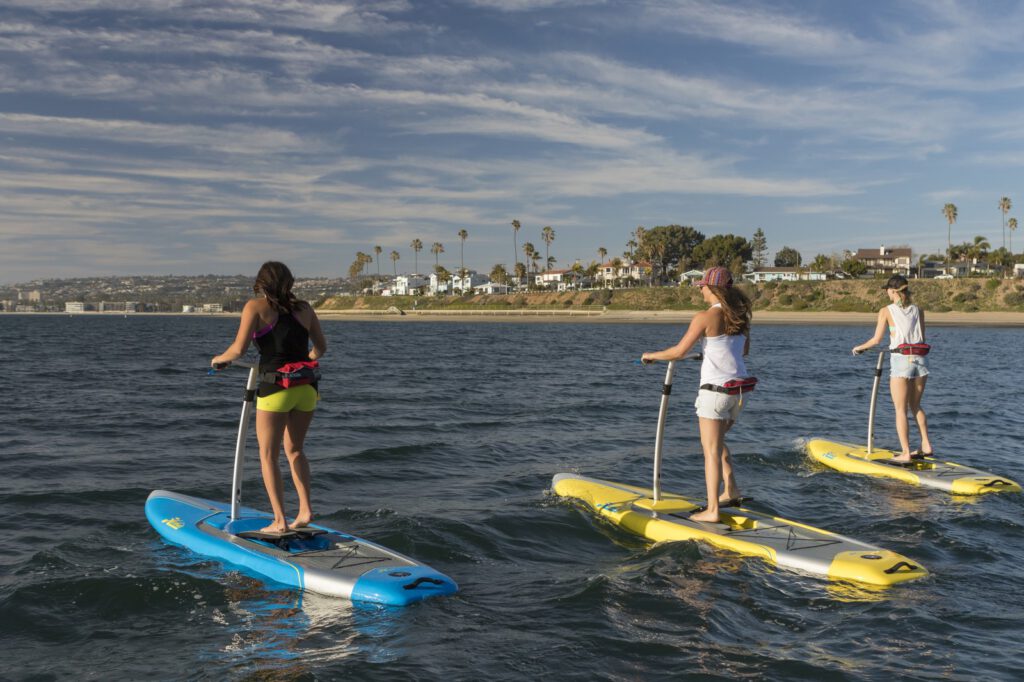
In the the beginning, some 3,000 years ago, Peruvian fishermen stood atop their caballitos de totoras, using split-end bamboo poles to propel themselves through the shallows. While their “little horses made of reed” were officially workboats, the fishermen were known to occasionally pull a move riding the surf to shore with a certain Laird Hamiltonesque panache. Over the next couple thousand years, fishermen in other parts of the world would fashion similar reed horses of their own.
More recently — perhaps as recently as two or three centuries back— fun-loving Hawaiians who had yet to de-paradised by anti-fun missionaries turned the workhorse into a playhorse, standing atop a more sleek board and using the paddle first to get out to the break, then to help carve on the ride in. It was, as Standup Journal notes, an evolution nearly inevitable: “Modern stand up paddling is inherently recognized as a valuable skill by our inner prehistoric selves.”
And so it should come as no surprise that the evolution of the standup paddleboard, as a conveyance for both function and fun, continues with the standup paddleboard’s latest innovation: the standup pedalboard. It’s the oddball marriage of paddling and pedaling into perambulating fun.
Hobie, which has a 66-year history of taking fun on the water and making it funner, introduced the standup pedalboard this spring with the Mirage Eclipse, which replaces a single long paddle with the MirageDrive pedal system it uses in its fishing kayaks. The MirageDrive system is powered by a stepping motion that’s a bit like working out on a stair-stepper at the gym. The motion powers a pair of underwater fins that flap sideways, then snug-up against the bottom of the board when it’s time to land. Riders steer with handlebars mounted on an adjustable aluminum shaft: squeeze a caliper on the right handle to go right, squeeze the left to go left. (There’s also a cup holder and universal phone mount.) The MirageDrive pedal system and handlebars detach for transport.
It’s hard not to look at the Hobie Mirage Eclipse and picture it as a bicycle on water — and thus picture how the board might fit into your active lifestyle. For instance, instead of weekend group bike rides around Jordan Lake, you could be looking at weekend group rides on Jordan Lake.
Remember when the Eastern Carolina version of the MS 150 used to ride from Raleigh to New Bern and back? Picture a standup pedalboard version of the ride down the Neuse River to New Bern (though not necessarily back). The recreational weekend cyclist who explores the vast greenway system on weekends could now supplement those greenway rides with blueway pedalboard rides on local waterways.
The pedalboard seems especially well-suited for exploring coastal waters, especially blackwater creeks, swamps and marshes. Kayaking these waters is swell; the elevated view from the standup pedalboard would be even more visually rewarding. The Mirage Eclipse comes in lengths of 10 feet, 6 inches (the 10.5) and 12 feet (the 12), offering sufficient space to accommodate a hefty dry bag anchored by bungees on the rear deck. Instead of a canoe trip to the 14 camping platforms on the Roanoke River, picture a standup pedalboard trip! (Not to mention “tours” to the Roanoke River Partners’ 29 other camping platforms in the region.)
Can standup pedalboard crits be far behind? In the late 1960s, Hobart “Hobie” Alter introduced the Hobie Cat, a small catamaran that initially had folks scratching their heads. That scratch turned into an itch: sailors everywhere were itching to have one. The Hobie Cat remains one of the most popular sailboats sold today. Don’t be surprised if the Mirage Eclipse follows suit.
